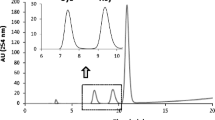Abstract
The aim of the study was to develop an inductively coupled plasma mass spectrometry (ICPMS) method for robust and simple routine determination of selenium in serum. Polyatomic interferences on 76Se, 77Se, and 78Se were removed by applying an octopole reaction system ICPMS with the reaction cell pressurized with H2 gas. We developed a novel simple optimization routine for the H2 gas flow based on a signal-to-noise ratio (SNR) calculation of the selenium signal measured in a single selenium standard. The optimum H2 flow was 2.9 mL min−1. The selenium content in serum was determined after a 50-fold dilution with 0.16 M HNO3 and quantified by using addition calibration and gallium as an internal standard. The method detection limit was 0.10 μg L−1 for 76Se and 78Se and 0.13 μg L−1 for 77Se. Human serum samples from a case-control study investigating if selenium was associated with risk of colorectal adenoma were analyzed. The average selenium concentration for the control group (n=768) was 137.1 μg L−1 and the range was 73.4–305.5 μg L−1. The within-batch repeatability (a batch is ten samples) estimated from 182 replicate analyses was 6.3% coefficient of variation (CV), whereas the between-batch repeatability was 7.4% CV estimated from 361 replicates between batches. The method accuracy was evaluated by analysis of a human serum certified reference material (Seronorm Serum level II, Sero A/S, Norway). There was a fairly good agreement between the measured average of 145±3 μg L−1 (n=36) and the certified value of 136±9 μg L−1. In addition the method was successfully applied for analysis of zinc serum concentrations without further optimization. For the Seronorm certified reference material a value of 911±75 μg L−1 (n=31) for zinc was obtained, which corresponds well to the certified zinc value of 920±60 μg L−1.




Similar content being viewed by others
References
Combs GFJ, Clark LC, Turnbull BW (2001) Biofactors 14:153–159
Vinceti M, Rovesti S, Bergomi M, Vivoli G (2000) Tumori 86:105–118
Klein EA, Thompson IM, Lippman SM, Goodman PJ, Albanes D, Taylor PR, Coltman C (2001) Trial J Urol 166:1311–1315
Willet W (1998) Nutritional epidemiology, 2nd edn. Oxford University Press, New York
Early DS, Hill K, Burk R, Palmer I (2002) Am J Gastroenterol 97:745–748
Ghadirian P, Maisonneuve P, Perret C, Kennedy G, Boyle P, Krewski D, Lacroix A (2000) Cancer Detect Prev 24:305–313
Knekt P, Aromaa A, Maatela J, Alfthan G, Aaran RK, Hakama M, Hakulinen T, Peto R, Teppo L (1990) J Natl Cancer Inst 82:864–868
Van den Brandt PA, Goldbohm RA, Bode P, Dorant E, Hermus RJ, Sturmans F (1993) J Natl Cancer Inst 85:224–229
Wallace K, Byers T, Morris JS, Cole BF, Greenberg ER, Baron J, Gudino A, Spate V, Karagas M (2003) Cancer Epidemiol Biomarkers Prev 12:464–467
Rose G (1981) Br Med J (Clin Res Ed) 282:1847–1851
Welz B, Sperling M (1999) Atomic absorption spectrometry, 3rd edn. Wiley-VCH, Weinheim
Taylor HE, Huff RA, Montaser A (1998) Novel applications of ICPMS. In: Montaser A (ed) Inductively coupled plasma mass spectrometry, 1st edn. Wiley-VCH, New York
Vanhoe H, Goossens J, Moens L, Dams R (1994) J Anal At Spectrom 9:177–185
Rodushkin I, Ödman F, Olofsson R, Axelsson MD (2000) J Anal At Spectrom 15:937–944
Feldmann I, Jakubowski N, Stuewer D (1999) Fresenius J Anal Chem 365:415–421
Feldmann I, Jakubowski N, Thomas C, Stuewer D (1999) Fresenius J Anal Chem 365:422–428
Boulyga SF, Becker JS (2001) Fresenius J Anal Chem 370:618–623
Sloth JJ, Larsen EH, Bügel S, Moesgaard S (2003) J Anal At Spectrom 18:317–322
Featherstone AM, Townsend AT, Jacobson GA, Peterson GM (2004) Anal Chim Acta 512:319–327
Moens L, Verrept P, Dams R, Greb U, Jung G, Laser B (1994) J Anal At Spectrom 9:1075–1078
Larsen EH, Stürup S (1994) J Anal At Spectrom 9:1099–1105
Allain P, Jaunault L, Mauras Y, Mermet JM, Delaporte T (1991) Anal Chem 63:1497–1498
Goossens J, VanHaecke F, Moens L, Dams R (1993) Anal Chim Acta 280:137–143
Nelms S (2003) Am Biotechnol Lab 39–41
Nixon DE, Neubauer KR, Eckdahl SJ, Butz JA, Burritt MF (2003) Spectrochim Acta Part B 58:97–110
Labat L, Dehon B, Lhermitte M (2003) Anal Bioanal Chem 376:270–273
Reyes LH, Gayon JMM, Alonso JIG, Sanz-Medel A (2003) J Anal At Spectrom 18:11–16
Peters U, Hayes RB, Chatterjee N, Church TR, Mayo C, Stürup S, Chanock SJ, Foster CB (2004) Serum selenium and genetic variation in the selenoprotein GPX1 and risk of colorectal adenoma. American Association for Cancer Research, Orlando, Florida
Gohagen JK, Prorok PC, Hayes RB, Kramer BS (2000) Control Clin Trials 21:251S–272S
Hayes RB, Reding D, Kopp W, Subar AF, Bhat N, Rothman N (2000) Control Clin Trials 21:349S–355S
Douglas DJ, Tanner SD (1998) Fundamental considerations in ICPMS. In: Montaser A (ed) Inductively coupled plasma mass spectrometry, 1st edn. Wiley-VCH, New York
Caroli S, Alimonti E, Coni F, Petrucci F, Senofonte O, Violante N (1994) Crit Rev Anal Chem 24:363–398
Ingle C, Appelblad PK, Dexter M, Reid H, Sharp BL (2001) J Anal At Spectrom 16:1076–1084
Yamada N, Takahashi J, Sakata K (2002) J Anal At Spectrom 17:1213–1222
van Veen EH, Bosch S, de Loos-Vollebregt MTC (1996) Spectrochim Acta Part B 51:591–608
FAO/WHO (2002) Human vitamin and mineral requirements. World Health Organization (WHO), Rome
Zaichick V, Sviridova TV, Zaichick SV (1997) Int Urol Nephrol 29:565–574
Author information
Authors and Affiliations
Corresponding author
Rights and permissions
About this article
Cite this article
Stürup, S., Hayes, R.B. & Peters, U. Development and application of a simple routine method for the determination of selenium in serum by octopole reaction system ICPMS. Anal Bioanal Chem 381, 686–694 (2005). https://doi.org/10.1007/s00216-004-2946-x
Received:
Revised:
Accepted:
Published:
Issue Date:
DOI: https://doi.org/10.1007/s00216-004-2946-x




